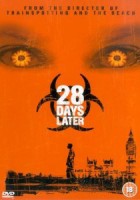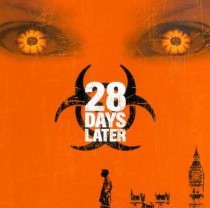 In 28 Days Later, Danny Boyle delivers a post-apocalyptic vision of London peopled by wild-eyed lunatics infected with pure rage. They chase ordinary folk through the streets of the capital howling in pain and anger and are prone to projectile vomiting. It doesn’t sound too different from the West End on a normal Friday night, says Martin McGrath.
In 28 Days Later, Danny Boyle delivers a post-apocalyptic vision of London peopled by wild-eyed lunatics infected with pure rage. They chase ordinary folk through the streets of the capital howling in pain and anger and are prone to projectile vomiting. It doesn’t sound too different from the West End on a normal Friday night, says Martin McGrath.
Zombies were never scary. They lumbered and crumbled and wobbled towards the hero in such predictable ways that dying of boredom should have been more of a risk than actual contact with the living dead.
In 28 Days Later, however, the ‘infected’ sprint like Olympians. They bound over obstacles. They leap headlong through plate glass. And all the while they howl like wounded animals. These are monsters
I stand in a tiny minority because I was never much of a fan of director Danny Boyles first two movies, Shallow Grave and Trainspotting. Indeed the only Boyle film I have previously had much time for (excluding the Inspector Morse episode “Masonic Mysteries”) is the widely reviled A Life Less Ordinary.
There is nothing in Boyle’s past, though, that prepared me for 28 Days Later, an effective, entertaining sci-fi action movie that, while not perfect, does marry a fantastic aesthetic with real, sweaty-palmed fright.
Let me start with the problems. There is no denying the stupidity of the science behind the film’s premise. Chimpanzees infected with “pure rage” are released by hapless animal rights activists. The infection spreads to humans and across the nation, wiping out the vast majority of the population within weeks. It is silly, but it doesn’t spoil the film.
Boyle has said that the script appealed to him because anyone who has been to London knows what it is to feel rage. Travelling by car, or on a crowded train, or even walking down Oxford Street, the sheer mass of people in a city like London raises hackles. I agree. I lived and worked in London and know exactly what he means, but it didn’t need the distraction of the pseudo-scientific introduction to make that point.
Still, the viewer can take the spread of “rage” as an allegorical device or ignore it and just enjoy an adrenaline-packed movie.
Alex Garland’s script is also occasionally clunky. One speech by Hannah (Megan Burns) is so wooden you expect her to sprout branches and roots. Also, early in the film there is too much exposition through shouting. This is normally a sign that a writer isn’t confident in his material and doesn’t want to take the risk that the audience might stop and think about what the characters are saying.
Most crucially, though, the second act sags dramatically and about half way through you begin to wonder whether the film has shown you all that it has to offer. Persevere. The final showdown between the infected and a rag-tag band of British soldiers delivers thrills aplenty.
Despite these weaknesses, 28 Days Later also has enormous strengths. It looks amazing. The opening sequence in a deserted London has been much discussed and deservedly praised. The use of handheld digital cameras gives every frame a muted, grainy look that simply hasn’t been seen before in mainstream cinema. It isn’t beautiful, but harnessed tightly to expert story-telling, it adds immensely to the atmosphere.
Boyle showed with Trainspotting that he could use music to brilliant effect. In 28 Days Later he takes this a step further – not only is the music intelligently employed but the whole soundscape is brilliantly constructed to deepen the viewer’s experience and increase the tension. The slow building music that accompanies Jim (Cillian Murphy) through the deserted streets of London comes to an ear-battering, screeching conclusion as he realises the scale of the disaster. And the spine-tingling version of “Abide With Me” must rank alongside A Night to Remember as the best use of this hymn in a movie.
Praise must also go to the sound engineers involved who have created a complex and multi-layered world of sound that still manages to remain clear and sharp, so that the howling of the infected echoes across and empty London.
Despite some stiff performances, some of the actors are excellent. Relative newcomer, Cillian Murphy, as the film’s hero Jim, manages the transition from innocence and terror to murderous determination while retaining the audience’s sympathy. Naomi Harris, as Selena, has a harder time with a part that asks her to perform wild emotional flips, but she too is very good. And Brendan Gleeson (The General) is a fine actor who quickly and convincingly become the father figure for all the main characters.
But the real stars of this film are the infected. They are swift and fierce and furious and they continually keep you on your toes. Some horror movies descend into predictable jump-out-of-the-dark scares. Boyle avoids this and he keeps you caring for the central characters even in the action sequences. By the end you might even find yourself cheering for the monsters. I know I was.
There is no denying that 28 Days Later has flaws. It’s hard to ignore the problems of pacing and occassionally stiff acting. But as a piece of entertainment it is the kind of science fiction film that, frankly, I thought British cinema no longer capable of making. Made for the (relatively) modest sum of £10 million, 28 Days Later proves that the making of genuine blockbuster science fiction does not need to be the sole preserve of Hollywood studios.
With imagination and talent, it is possible to make films that beat the Americans at their own game. Clever and tense and filled with foreboding, 28 Days Later deserves your attention. Like the infected, I predict this one will run and run.
